Learn how Connected Kingston changed the way people in the borough find help and information by bringing everything together in one place.
Back in 2018, teams at the Royal Borough of Kingston identified that there were gaps in the way information around services was presented. Residents were falling through these gaps, and something had to be done.
After a lot of research, interviews, and workshops, Kingston’s Public Health team knew they needed to create a centralised information hub, and that’s where we came in at Ayup Digital.
We caught up with Tony Al Hosri - Public Health Officer, Katharine Dallas - Health in All Policies Lead, and Daniel Green - Corporate Head of Health Behaviours & Public Health Services to revisit Kingston’s journey towards Connected Kingston.
Discover how Kingston’s proactive identification of a critical information gap led to a localised platform where people now have access to vital resources in the right place at the right time.
Identifying a gap: why multiple directories needed an overhaul #
Before we started working with Ayup Digital on Connected Kingston, we were looking at how we could support people at an earlier, preventative stage before they accessed services to support more complex needs, including adult social care and homelessness services.
We held some workshops which looked at how people got their information, and what became clear was that there was a lot of information across different services and different directories. It made it quite confusing for people to navigate to the support they needed.
From our end, we understood this issue. Most people visit a council website for a service they know the council offers, or for specific information, such as bin collection days. There’s less information about health and wellbeing, or voluntary sector and community information.
This created the problem of lots of directories that became out of date and unwieldy because there were so many of them and they were owned by services who didn't have enough time to keep them current.
We came away from our research with really in-depth information not just from services, but also from users and residents. It showed us that we needed to do things differently, we needed to promote ourselves differently, and we needed to help provide information to people earlier.
We needed to do things differently, we needed to promote ourselves differently, and we needed to help provide information to people earlier.
Finding the right fit with our platform provider #
This research started us on a journey to secure funding for a prevention platform - something that allowed people to connect to support services in the community. With funding from the Department for Communities and Local Government (DCLG) and Public Health England (UK Health Security Agency), we were ready to get started.
The idea of having a referral feature on our platform meant that we could link in with the work the NHS was doing on building on the social prescribing approach, which was happening around the same time. We’d already done a lot of work around user-centred design, and the NHS’ own focus reaffirmed our approach.
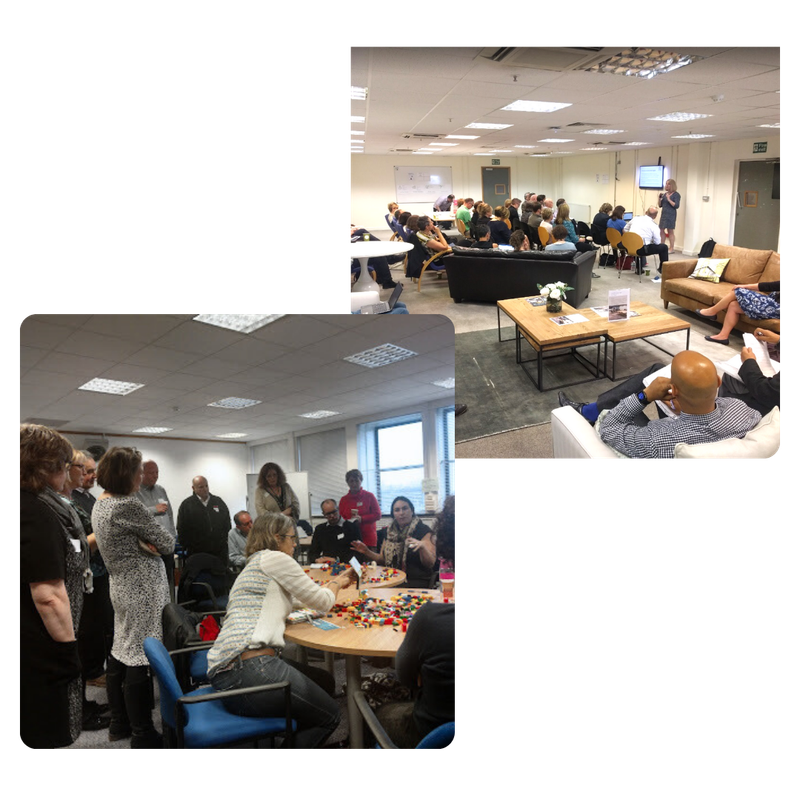
We chose Ayup Digital to help us build the platform, and it was clear from the beginning they were the right fit for what we wanted to do. The team did a lot of engagement work with our voluntary sector, statutory, and council partners.
Right from the start, there were lots of breakout groups and interesting engagement exercises. They interacted brilliantly with people from different backgrounds and areas which helped people understand the scope of what the voluntary sector could offer.
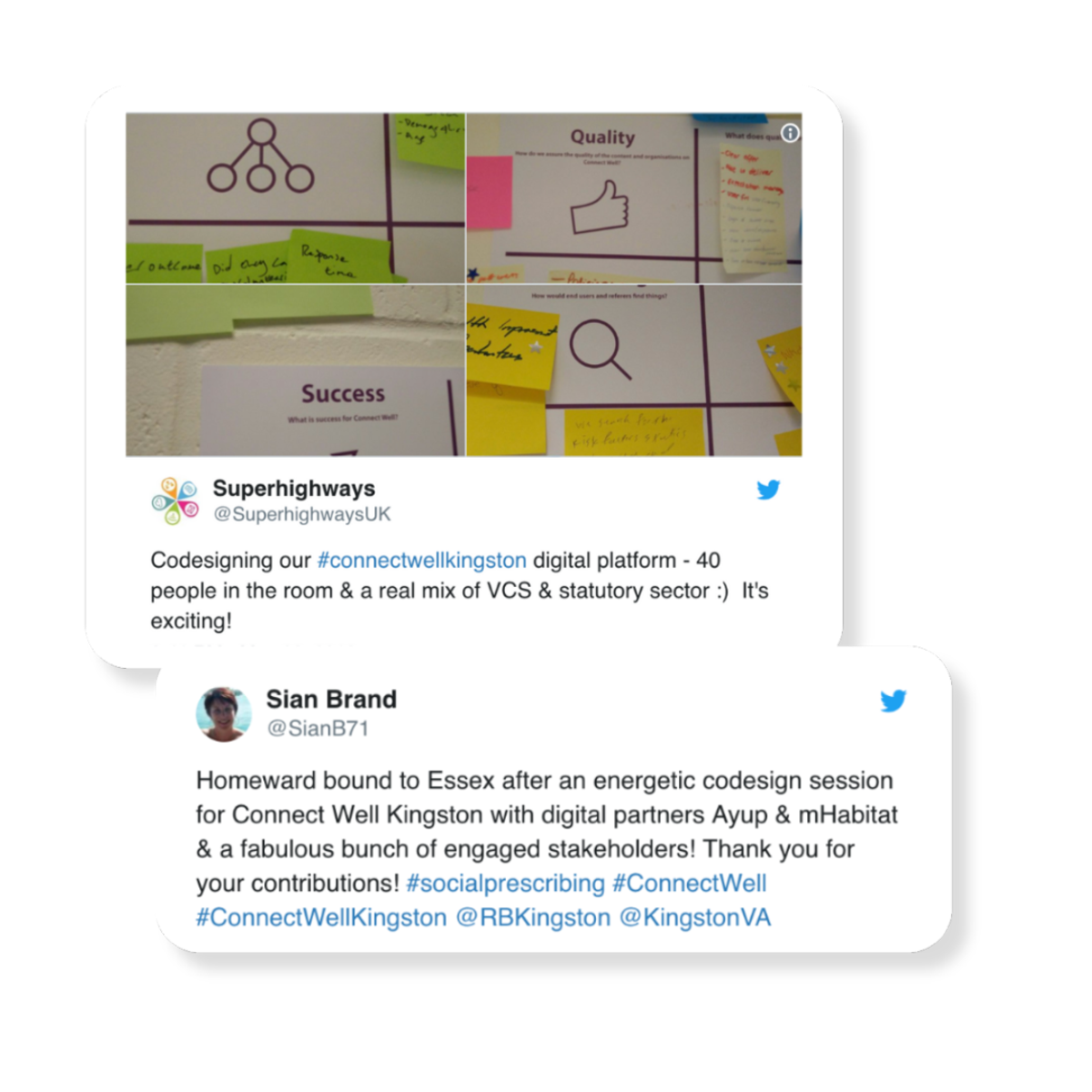
A dynamic new hub of information that responds to the community #
With Connected Kingston, we essentially have a marketplace of things that we can signpost and refer people to. We need the resident journey to be as straightforward as possible and it would be difficult if not impossible now to go back to compiling a list of services in a document. We want to send them to one place where they can explore things for themselves, rather than giving them 20 different links.
Being able to have flexible categories gives us the ability to build and curate our lists in interesting and relevant ways. We can handpick services and activities and mould our website in such a way to support different campaigns or responses to things happening in the community.
There's an element of curation on the Connected Kingston platform. You might have a walking group that someone tries out because they want to improve their mental health, make friends, or get active. We can have three different pages that lead into that one listing.
It’s more human and gives us a lot more freedom to set up our directory in a way that makes sense to how people search while catering to different needs.
COVID-19 was a good example of this. We learned so much about the importance of being able to reach people where they were, so we did a lot of communication through social media while optimising for Google to respond to people’s searches. We ran and monitored social media adverts every single day to make sure that essential information was being delivered to those looking for it and received lots of positive feedback from residents.
For example, we knew people were worried about getting food and were making online searches relating to this, and so we ran a campaign to ensure our ‘Help to Get Food’ page on Connected Kingston was coming up as one of the search results. Our page showed residents relevant resources, like where they could secure community food parcels, and how to book priority delivery slots. Being there at a time when people needed support has helped build a level of trust and raised our profile significantly.
We were able to mobilise and update our platform incredibly quickly, and having a platform that’s separate from the council website also enables us to adopt a unique tone with our messaging. You can lead with a question, like, “Are you worried about housing?” rather than “This is your housing service”.
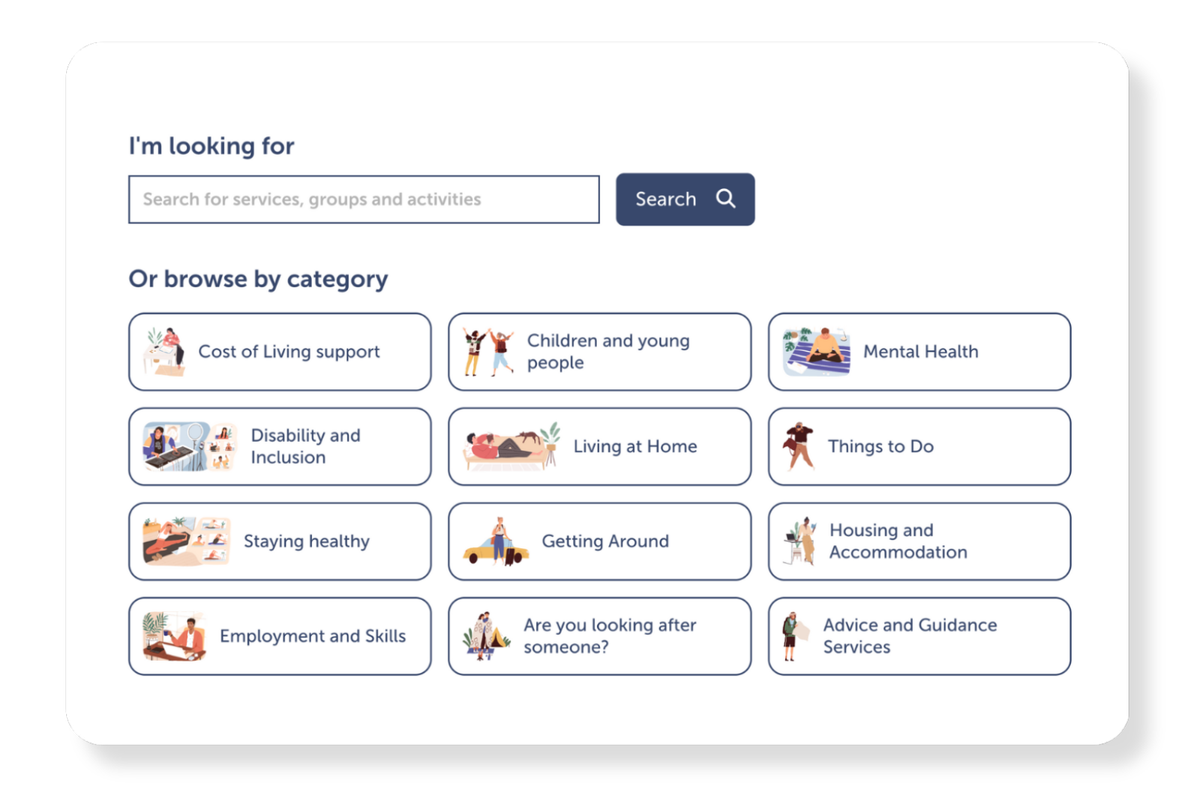
Another example is of the statutory process around bereavement which the council website outlines, but on Connected Kingston, we can provide more of the wraparound, community and holistic support for someone who has suffered a bereavement. A lot of what makes Connected Kingston approachable comes from the kind of language you use to describe a service, and there’s a lot more flexibility on the platform for community and voluntary groups to describe their service in their own words. Again, it helps build trust.
Easy management of a shared community asset #
Creating a central directory of services has meant we can work in partnership with voluntary organisations in new and exciting ways.
There’s no hierarchy, and we can support the voluntary sector and celebrate what they’re doing. It feels more inclusive as we work together on a shared community asset.
We can blend the council offer and the community offer in a single space so that people don't feel like they've got to go to two separate places to get the different kinds of information that all apply to one thing. This collaboration is fundamental to how we use Connected Kingston and the platform features facilitate this.
Connected Kingston lets us see when something was last updated, and, if necessary, ask people to make sure the information is up to date and can be trusted. With backend access to our platform, we are able to be really responsive to local and national priorities that may emerge.
With backend access to our platform, we are able to be really responsive to local and national priorities that may emerge.
It is useful to have a distinction between the information that will sit better on the council website and what belongs on Connected Kingston. Connected Kingston has a wide scope in terms of representing the voluntary and community sector offers.
Between the council website and Connected Kingston we cover a lot of information, and as a result residents will find that both platforms signpost to each other as appropriate. It's great that this synergy between the community offer and the council's information pages exist and hopefully it makes it easy for people to stay informed and to stay healthy.
Kingston’s success benchmarks for a new community directory #
When we set out to create a platform that brings together important information for residents, there were a few ways we wanted to measure success. The number of services, groups, and activities on the directory would be a good indication of buy-in from organisations offering support.
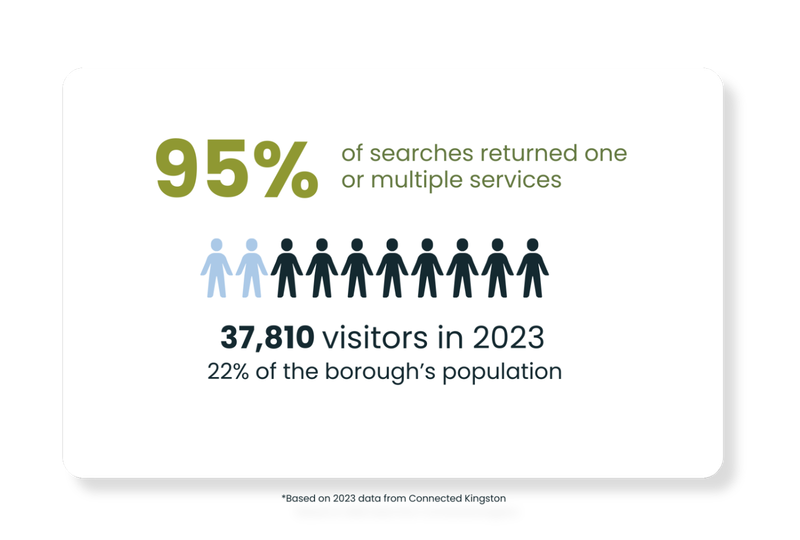
Website traffic would show us that residents were using it, and we also wanted to see how people interacted with the website. That’s because success to us also meant navigating people to the information we think they may need, without them necessarily organically searching for it. In 2023, we had over 37,810 visitors to Connected Kingston, representing just over 22% of the borough’s population.
These visits resulted in 16,570 searches, 95% of which returned one or multiple services.
The most frequently searched terms in 2023 tied into social connections, which drew in searches around words like “friend”, “social” and “lonely”. After that, the most popular searches were linked to Mental Health. This was followed by terms relating to health and fitness, including searches such as “weight loss” as well as those relating to specific activities including “walking”, “yoga” and “swim”.
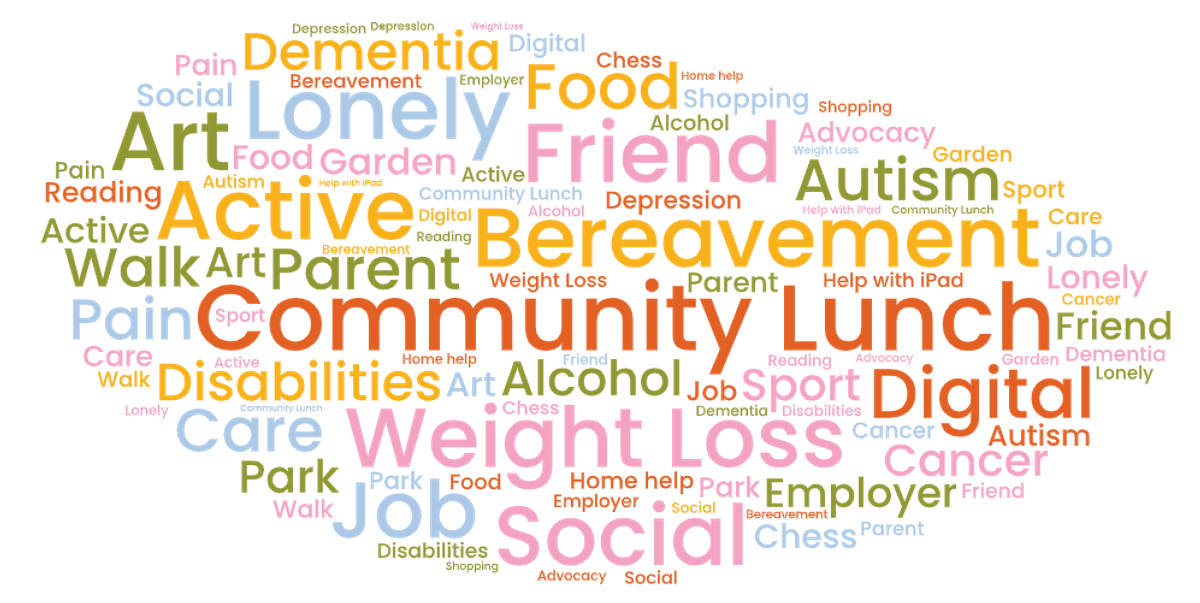
The platform’s reporting capability lets us analyse this data to see what people are looking for, how many people are seeking out the same information, and how many services have come up in that search.
We can use this data to get a clear understanding of how our platform needs to evolve, as well as where we need to focus in terms of commissioning new services in the future, so we can continue to serve the community.
We’ve also seen searches in multiple different languages across the borough, including Cantonese, Italian, Bulgarian and Caribbean, so the translation function of Connected Kingston is really important and something we want to develop.
Beyond community engagement and voluntary service collaboration, it was important to us that other departments across the council could see the value in such a platform too. When we launched Connected Kingston, we saw a change in how the council would talk about its services, and how we could share the same information differently on Connected Kingston in a way that was more friendly and accessible.
We currently have over 610 services from 344 organisations listed on Connected Kingston, and the more areas and teams that are bought into it and use it, the more successful it will be. Because that's the whole point; it's a big collaboration and a single point of information.
We couldn’t have asked for a better partner in the creation and deployment of Connected Kingston than Ayup Digital, and we’re very grateful to have a continued positive working relationship with them.
We couldn’t have asked for a better partner in the creation and deployment of Connected Kingston than Ayup Digital.
Contributors
Ayup Digital would like to thank the Royal Borough of Kingston Council and our contributors to this article:
Tony Al Hosri - Public Health Officer
Katharine Dallas - Health in All Policies Lead
Daniel Green - Corporate Head of Health Behaviours & Public Health Services